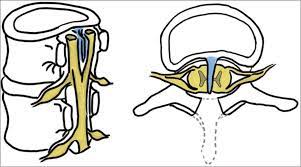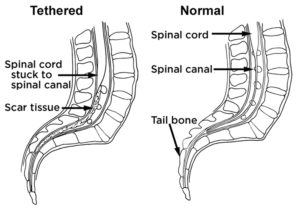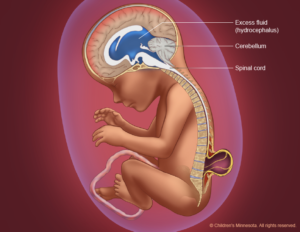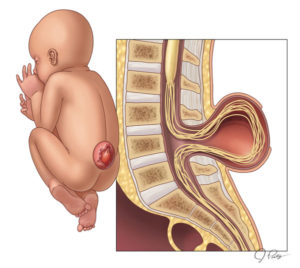 SPINA BIFIDA
SPINA BIFIDA
TETHERED SPINALCORD (shown above)
FETUS WITH HYDROCEPHALUS (shown above)
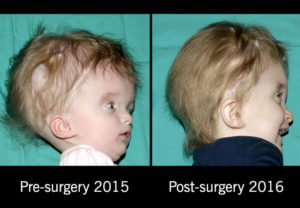 HYDROCEPHALUS
HYDROCEPHALUS
Spina Bifida is one of the causes of Tethered Spinal Cord and Hydrocephalus.
Tethered Spinal Cord is a stretch-induced functional disorder associated with the fixation (tethering) effect of inelastic tissue on the caudal spinal cord, limiting its movement. This abnormal attachment is associated with progressive stretching and increased tension of the spinal cord as a child ages, potentially resulting in a variety of neurological and other symptoms.
Hydrocephalus is caused by either increased production of CSF or impaired circulation and absorption
Spina bifida is a birth defect that affects the spine. Here are the latest national statistics on spina bifida in the United States:
1.)Each year, about 1,400 babies are born with spina bifida, or 1 in every 2,758 births, according to the U.S. Centers for Disease Control and Prevention. The exact cause of spina bifida is unknown. There is no cure but most people with spina bifida lead long and productive lives.
2.)Who it effects the most: Hispanic women have the highest rate of having a child affected by spina bifida, when compared with non-Hispanic white and non-Hispanic black women. Data from 12 state-based birth defects tracking programs were used to estimate the total number of pregnancies affected by spina bifida compared to the total number of live births (also called the prevalence of spina bifida) for each racial/ethnic group:
- Hispanic: 3.80 per 10,000 live births
- Non-Hispanic black or African-American: 2.73 per 10,000 live births
- Non-Hispanic white: 3.09 per 10,000 live births
The symptoms listed below are some of the ways in which tethered spinal cord syndrome may be exhibited in children:
- Lesion on the lower back
- Fatty tumor or deep dimple on the lower back
- Skin discoloration on the lower back
- Hairy patch on the lower back
- Back pain, worsened by activity and relieved with rest
- Leg pain, especially in the back of legs
- Leg numbness or tingling
- Changes in leg strength
- Progressive or repeated muscle contractions
- Bowel and bladder problems
Spina bifida consequences that may occur, know the type of the spina bifida gives an idea of how many problems the patient will have:
- Abnormal sensation or paralysis, which mostly occurs with closed neural tube defects and myelomeningocele. People with these conditions typically have some degree of leg and core muscle weakness and loss of feeling in the groin and feet or legs. The sensation can be more significant on one side of the body.
- You may see deterioration of the gait in the patient’s walking. Typically, the lower in the spine where the condition occurs results in less weakness and loss of feeling. The strength and feeling do not improve with age due to nerve damage. People with these types of spina bifida may lose strength and sensation as they grow and mobility can become more difficult with age. People with these conditions may walk independently or use some combination of leg braces, walkers, crutches, or wheelchairs. As they age, they may require more of these supports.
- Chiari II malformation, in which parts of the brain called the brain stem and the cerebellum (hindbrain) protrude downward into the spinal canal or neck area. It is almost always seen on advanced imagining of the brain in people with myelomeningocele, but it rarely causes symptoms. When it does, this condition can press on the spinal cord and cause a variety of symptoms including difficulty breathing, swallowing, and arm weakness. Surgery is sometimes required to reduce pressure in this area.
- Blockage of cerebrospinal fluid, causing a condition called hydrocephalus. Hydrocephalus is the abnormal buildup of the fluid that surrounds the brain. Most people with myelomeningocele have this condition, which is not seen in the other types of spina bifida. This buildup can put damaging pressure on the brain. Hydrocephalus is commonly treated by surgically implanting a shunt—a hollow tube—in the brain which allows drainage of the excess fluid into the abdomen where it is absorbed by the body. The tube is tunneled under the skin and not very noticeable to others. Another treatment option is an endoscopic third ventriculostomy or ETV, a procedure that creates a new path for the fluid to flow.
- Meningitis, an infection in the meninges covering the brain. It can sometimes be associated with shunts. Meningitis may cause brain injury and can be life-threatening.
- Tethered cord syndrome can occur with all forms of spina bifida, although it is very rare in individuals with spina bifida occulta. Usually the spinal cord and nerves float freely. A tethered cord means that there is some type of tissue attached to and pulling the cord down. This can cause damage to the nerves and decrease feeling and strength, as well as problems with bowel and bladder control. It is surgically treated if a person has symptoms.
- Bowel and bladder incontinence affect most individuals with myelomeningocele and closed neural tube defects. The nerves at the very bottom of the spine control bowel and bladder function and don’t usually work properly in people with these types of spina bifida. Most people with myelomeningocele and some types of closed neural tube defects need a regimen or other assistance to drain their bladders periodically or to have regularly scheduled bowel movements.
- Learning disabilities, including difficulty paying attention, understanding concepts, impaired motor skills, impaired memory, and difficulty with organization and problem solving are commonly seen in children with myelomeningocele. People with strength lower down in their legs tend to have less difficulty than those with more leg weakness. Evaluation for an individualized education plan is recommended for all children with myelomeningocele.
- Other complications such as skin ulcers, low bone mineral density, impaired male fertility, obesity, and kidney failure can be seen in people with myelomeningocele and neural tube defects as they age. Additionally, people with myelomeningocele are at risk for precocious puberty (when changes to that of an adult occur too soon), sleep apnea, and depression.
The estimated lifetime cost of care for a person with spina bifida, with caregiving costs, is $791,900.
Learn tomorrow how you can prevent Spina Bifida with much more!
